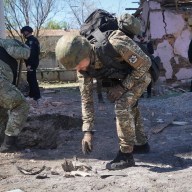SALAVAT, Afghanistan – Canadian forces invaded the village of Salavat this past week in another effort at disrupting a key insurgent staging area ahead of national elections the Taliban are determined to undermine.
The two-day operation saw the deployment of an entire battle group of Canadian infantry, combat engineers and tank crews – several hundred soldiers in all – along with close to 200 more Afghan army and police officers.
“The mission is to destroy the military component of the insurgents in the vicinity of Nakhoney to protect approaches to Kandahar,” infantry commander Maj. Steve Jourdain said on the eve of the operation.
“The aim is to clear Salavat, to suppress the insurgents’ freedom of movement in the area.”
In a briefing to his platoon leaders, Jourdain – a member of the Quebec-based Royal 22e Regiment (the Van Doos) – outlined the plan of action: seal off the entrances and exits to the village of 1,500, then sweep through from the north, searching every compound.
Insurgent activity had been spotted at one compound in particular, a former school, and one platoon was handed the responsibility of going in and securing it.
“No plans survive the start line,” Jourdain fretted.
“It’s going to be a nightmare.”
He had good reason to worry. The “fighting season” had dawned. Direct insurgent attacks were growing more frequent. Roadside bombs were maiming and killing people and crippling vehicles on a daily basis.
In an attempt at dampening the escalating threat, the Canadians were making the first of a series of planned big moves.
At first light Thursday, a large convoy of armoured vehicles and tanks moved from a nearby operating base toward a staging area just outside Salavat – an open field that within an hour had been transformed into a massive military encampment.
The start was not auspicious. An improvised explosive device exploded under an armoured vehicle, injuring three combat engineers – one of them seriously. All had to be flown out and the battle plan quickly rejigged.
One company sealed the exits from the village. Hours later, the array of firepower and manpower had assembled in the staging area, and the invasion began with a tank firing two shells through the outer wall of the former school.
In a tense few moments, an infantry platoon rushed in through the breach.
It was in a similar operation that Pte. Alexandre Peloquin died earlier this month after stepping on an explosive device, and the soldiers were taking no chances.
After checking the site carefully, with one descending to search a bunker that proved empty, they moved to a second residential compound, which intelligence reports indicated the insurgents had also been using.
An interpreter yelled a final warning, and combat engineers blew open the blue metal gate as troops, wary of ambush or booby traps, stormed in. The only signs of a life were few scared chickens.
Soldiers systematically smashed in the locked doors and searched every room, finding only a neat array of domestic items, including a baby crib, plastic flowers, sewing machines, laundry hanging to dry.
“We did a dynamic breach and just wanted to go in and clear the compounds before occupying them in order to proceed with the advance,” said platoon leader Lt. Josh Makuch, another member of the storied Van Doos.
Under the rules of engagement, Canadian soldiers can only smash their way into compounds – a “hard knock” – if they have solid intelligence of Taliban activity. Otherwise, the protocol is to let Afghan soldiers or police do the actual searches – the “soft knock.”
For the better part of two days, the Afghans, supported by the Canadians, combed the village and grape fields.
As has become increasingly common in this insurgent war, the Taliban did not show up to fight, melting away like ghosts, leaving some subtle and not-so-subtle signs of their presence.
In one grape field, troops found a stack of “shabnamah” – “night letters,” so named because the Taliban secretly distribute them under the cover of dark, nailing them to the doors of frightened villagers.
The neatly printed and photocopied screeds exhort Afghans to unite in holy war to drive the foreign forces out of Afghanistan.
While some villagers simply glared at the influx of soldiers, others chatted and joked with the Afghan troops as the always cautious Canadian soldiers mostly kept their distance.
At one point, a village child notified the Afghan soldiers about an anti-personnel mine found on a path beside a field. A combat engineer blew it up.
By the end of the second day, the mission was deemed complete.
Afghan forces had found about 80 kilograms of explosives, shell casings, military garb and some museum-era weapons. One man was detained.
If nothing else, the Canadians had forced the insurgents to move elsewhere or lie low – at least for the moment.
Jourdain, for one, was able to breathe a little easier.
“It proved to be a real success,” he said as the massive array of Canadian firepower melted away from the staging area.
















